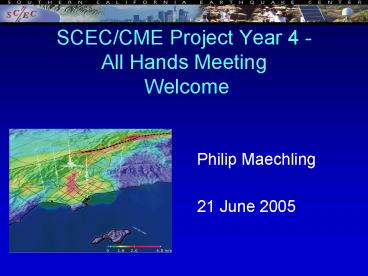SCECCME Project Year 4 All Hands Meeting Welcome PowerPoint PPT Presentation
1 / 42
Title: SCECCME Project Year 4 All Hands Meeting Welcome
1
SCEC/CME Project Year 4 -All Hands Meeting
Welcome
- Philip Maechling
- 21 June 2005
2
SCEC/CME Project Work Areas Intersect with SCEC
Work Areas
- Earthquake Science
- Utilize the predictive power of fault-system
models and dynamic wavefield calculations to
improve seismic hazard analysis and reduce
earthquake risk - Computer Science / Information Technology
- Provide the Cyberinfrastructure to manage large,
complex sequences of calculations needed for
system-level earthquake science - Education
- Cross-train earth scientists and computer
scientists - Improve public use of earthquake knowledge
3
Running TeraShake Scale Simulations
4
TeraShake Simulation Results
5
CMU Hercules Tool chain
Highly scalable AWM software tools that uses new
technique called In-situ parallel mesh generation
6
CMU Hercules Tool chain
1994 Northridge Aftershock Animation
7
SDSC Visualization Tools
8
SDSC Visualization Tools
9
SDSC Visualization Tools
10
Data Discovery and Distribution System (DDDS)
11
SCEC Digital Library Developments
12
SCEC Digital Library Developments
13
IRIS Synthetic and Observed Seismogram Access
(SOSA) Developments
14
IRIS Synthetic and Observed Seismogram Access
(SOSA) Developments
15
OpenSHA Developments
16
OpenSHA Developments
17
Component-based Pathway 2 Simulations
18
Component-based Pathway 2 Simulations
19
Dynamic Rupture Comparison Tool
Comparison of Dynamic Rupture Models Rupture Test
Case Contours
20
Standardized Rupture Description Development
(Historical Ruptures)
21
Standardized Rupture Description Development
(Scenario Ruptures)
- Coarse slip distribution and hypocenter initially
specified
- Extend to fine-scale sampling using K-2 filter
(e.g. Somerville et al., 1999)
- Rupture time derived from simple scaling formula
22
Developing A Scientific Workflow System
23
Applying Knowledge Tools to Scientific Workflows
An Integrated Scientific Workflow System
PCT
CAT
WorkflowT Editor
W Template Assistance
Query for components
D. Okaya _at_ USC
Workflow Template (WT)
Workflow Library
IDS
Query for WT
Workflow Instantiation
W Instance Assistance
Query for data/file
L. Hearn _at_ UBC
PowerLoom
MCS
Workflow Instance (WI)
Conceptual Data Query Engine
Metadata Catalog
Pegasus
Workflow Mapping
Grid info svcs
RLS
MDS
Grid
Executable Workflow
24
Concept-based Metadata Search Tool (DataFinder)
25
Concrete Workflow Generation and Mapping
26
Generating a Concrete Workflow
- Information
- location of files and component Instances
- State of the Grid resources
- Select specific
- Resources
- Files
- Add jobs required to form a concrete workflow
that can be executed in the Grid environment - Data movement
- Data registration
- Each component in the abstract workflow is turned
into an executable job
27
Mimetic Dynamic Rupture Code
28
Earthquake Source Ontology Development
29
F.E. Dynamic Rupture Code
Comparisons of a slip rate time history on the
fault of a dynamically propagating strike-slip
earthquake
30
Point Cloud Volume Visualization Software
31
CyberShake Project
- CyberShake Waveform-based Seismic Hazard Analysis
32
TeraShake 2 Project
- TeraShake 2 Dynamic Rupture-based Simulations
33
Synthetic Seismograms on Demand
- Pathway 2 Simulation Capabilities Validated and
Available
34
Welcome to the SCEC/CME 2005 All Hands Meeting
- Ask Questions and Contribute to Discussions.
- Find Problems to work On and People to Work with
for Year 5. - Communicate, Innovate, and create Transformative
Science
35
SCECs Mission
- SCECs Mission leads to Geoscientists working
together with Computer Scientists - Gather information about earthquakes
- Integrate into a physics-based understanding
- Communicate understanding to community
36
Seismic Hazard Analysis
- Definition Specification of the maximum
intensity of shaking expected at a site during a
fixed time interval - Example National seismic hazard maps
- Intensity measure peak ground acceleration (PGA)
- Interval 50 years
- Probability of exceedance 2
37
SHA Computational Pathways
Standardized Seismic Hazard Analysis Ground
motion simulation Physics-based earthquake
forecasting Ground-motion inverse problem
1
2
3
Other Data Geology Geodesy
4
Unified Structural Representation
Invert
4
Faults Motions Stresses
Anelastic model
Ground Motions
AWM
SRM
RDM
FSM
3
2
Intensity Measures
Earthquake Forecast Model
Attenuation Relationship
1
AWP Anelastic Wave Propagation SRM Site
Response Model
FSM Fault System Model RDM Rupture Dynamics
Model
38
SCEC/CME Project
Goal To develop a cyberinfrastructure that can
support system-level earthquake science the
SCEC Community Modeling Environment (CME)
Support 5-yr project funded by the NSF/ITR
program under the CISE and Geoscience
Directorates Start date Oct 1, 2001
NSF CISE GEO
SCEC/ITR Project
USGS
ISI
Information Science
Earth Science
SDSC
IRIS
SCEC Institutions
www.scec.org/cme
39
SCEC/CME Challenges
- Many geophysical models, computational programs,
and data sets and data types. - Large scale simulations, high performance
computing and large-scale data management are
required in a physics-based approach to
earthquake modeling at high spatial-temporal
resolution requires. - Communication tools, distributed model
development, and computer resource sharing are
required by the distributed SCEC collaboration.
40
SCEC Collaboratory for system-level earthquake
science
KNOWLEDGE REPRESENTATION REASONING Knowledge
Server Knowledge base access, Inference Translatio
n Services Syntactic semantic translation
Knowledge Base
Ontologies Curated taxonomies, Relations
constraints
Pathway Models Pathway templates, Models of
simulation codes
DIGITAL LIBRARIES Navigation Queries Versioning
, Replication Mediated Collections Federated acce
ss
KNOWLEDGE ACQUISITION Acquisition
Interfaces Dialog planning, Pathway
construction strategies Pathway Assembly Template
instantiation, Resource selection, Constraint
checking
Code Repositories
FSM
RDM
AWM
SRM
Users
Data Simulation Products
Data Collections
GRID Pathway Execution Policy, Data ingest,
Repository access Grid Services Compute storage
management, Security
Pathway Instantiations
Storage
Computing
41
SCEC Collaboratory for system-level earthquake
science
42
SCEC Collaboratory for system-level earthquake
science

